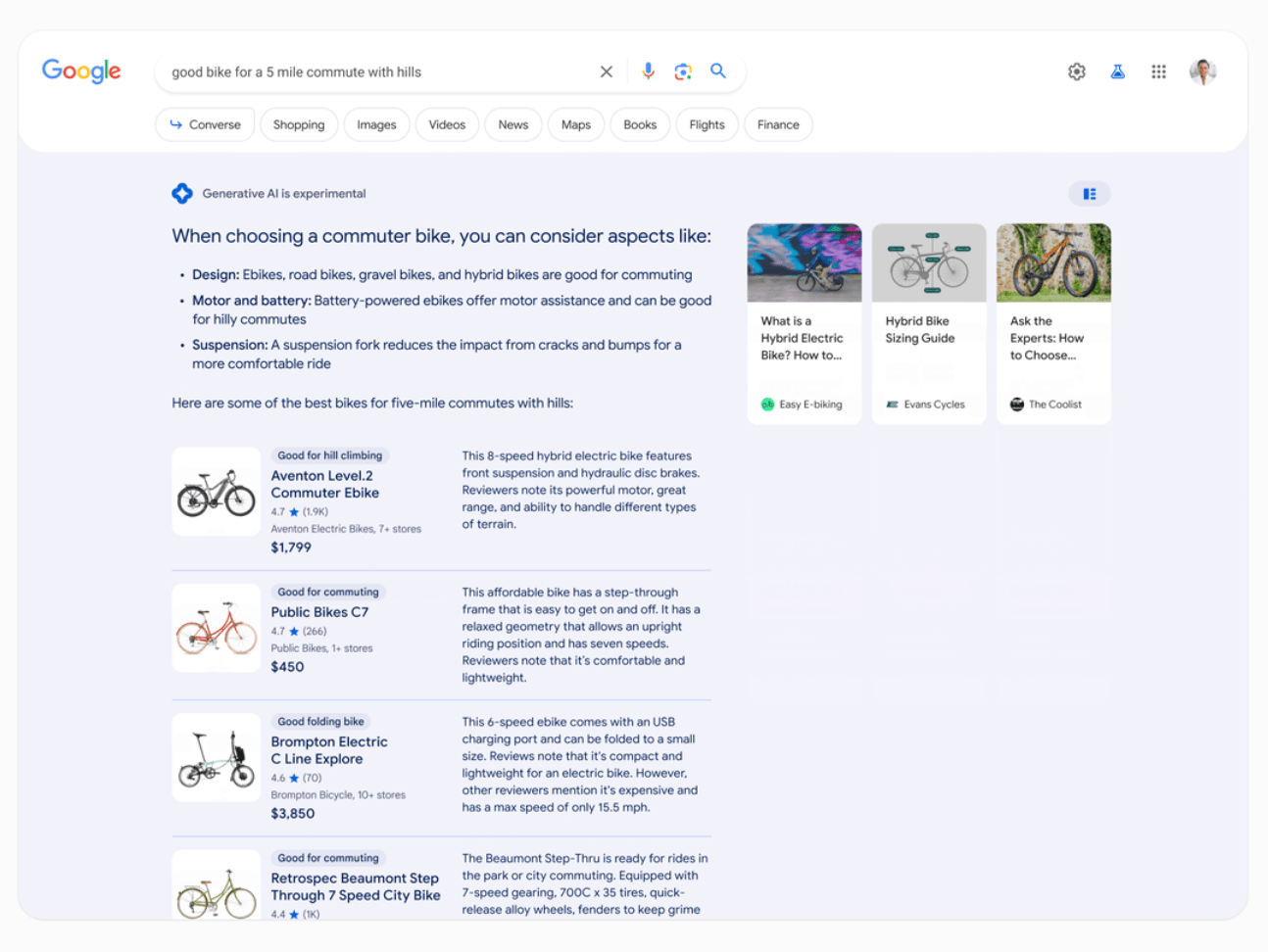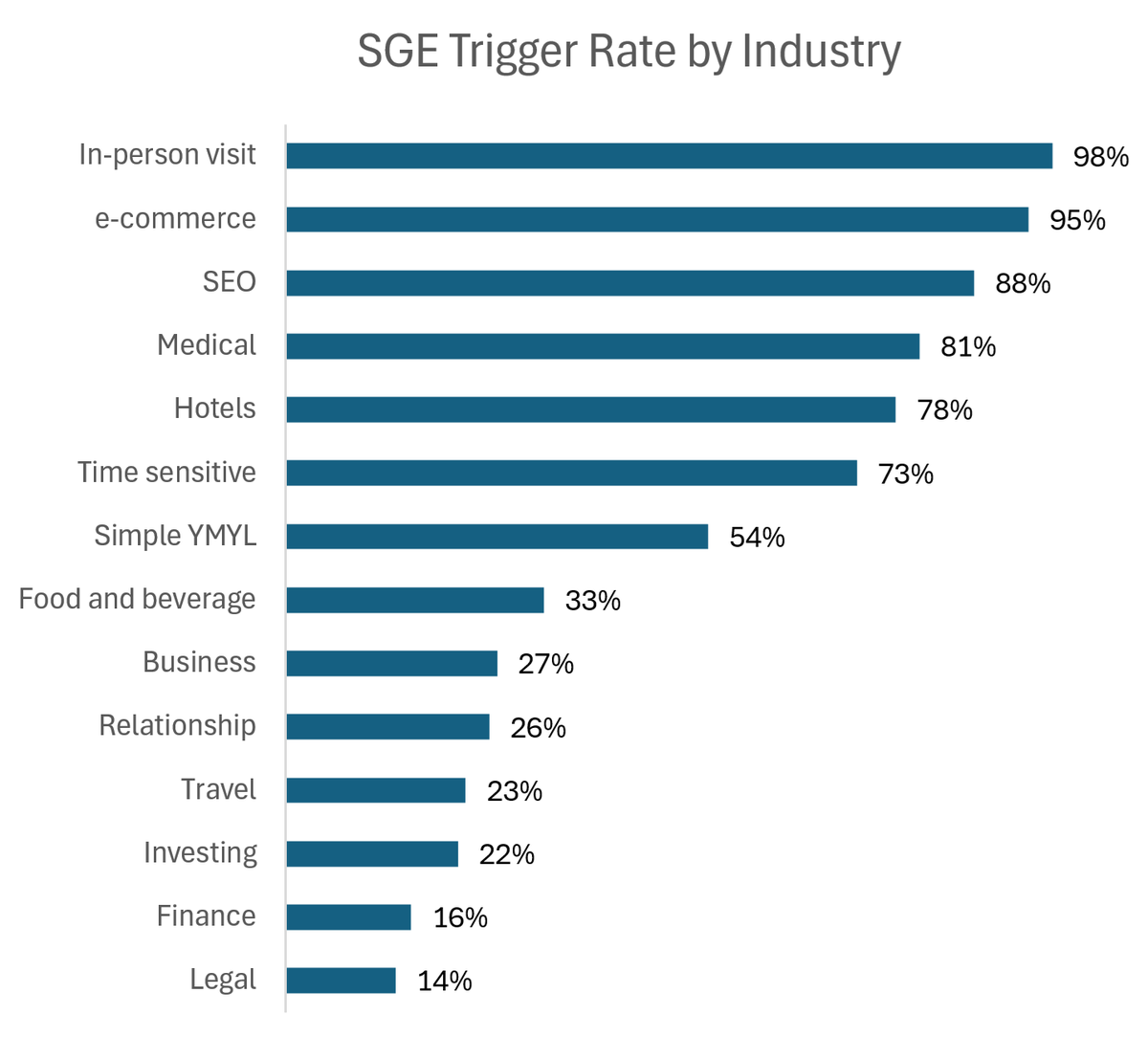What Is Google SGE?
Google Search Generative Experience or SGE is a new experimental experience for creating search results. It’s based on generative artificial intelligence (AI) that provides the user with a summary or overview of search topics without needing to click into specific webpages. If ChatGPT did search results, it wouldn’t be too dissimilar to this.
The feature can help users with a variety of tasks without ever looking at a webpage, such as:
- Answering user questions
- Summarising topics
- Giving key takeaways from various sources
- How-To Instructions
- Product roundups
For example:
When you’re looking for a bike that fits your needs, Google SGE will be able to understand the search and generate content specific to your search. In this case, it is even showing you a list of the best bikes for five-mile commutes with hills, with links to buy.
How Does Google SGE Work?
Google SGE, a generative AI feature, works similarly to other large language models (LLMs), like ChatGPT, where it uses algorithms and models to spawn content, which can include text, images, code and even videos.
Google has its own LLM called Pathways Language Model 2 (PaLM 2) which is deployed for all of Google’s products to give generative AI features to users. It’s a mix of natural language processing, machine learning and deep learning. This allows the AI to understand the user’s query and create relevant and useful content for the user in an appropriate response. Saving them from having to “search around” the web.
How Has Google Used AI In The Past?
AI has been involved in some way in Google Search for much longer than you might realise, here are some uses of AI by Google through the years:
RankBrain (2015)
This was the first use of AI in search by Google. RankBrain helped the algorithms Google used to rank sites understand how the words in search queries related to concepts in the real world.
“When we launched RankBrain in 2015, it was the first deep learning system deployed in Search. At the time, it was groundbreaking… RankBrain (as its name suggests) is used to help rank — or decide the best order for — top search results.” – Google
Neural Matching (2018)
This helped Google’s algorithms understand much broader concepts in search queries and how best to serve webpages that match the context and concept of that search.
SpamBrain (2018)
In Google’s pursuit of improving the quality of search results for users, it launched SpamBrain. An important implementation of AI that helped it find low-quality sites and improve rankings for sites that better answered user’s queries.
Google MUM (2021)
Before SGE was announced, Google’s Multitask Unified Model (MUM) was the most famous implementation of AI in search. A multimodal AI system that included understanding images and text in a deeper way with the ability to place them within the contexts of a search query.
It’s important to point out that all previous implementations of AI have been to the backend of the search experience, without the user knowing anything was changing. Google SGE, most likely in response to Microsoft’s integration of ChatGPT into Bing, is the largest change to the search experience in the foreground since Google was created.
What Are The Benefits of Google SGE?
It allows users to understand summaries of topics quickly and easily without having to spend time researching various sites and piecing different points and summaries together. Grasping the basics without an overwhelming amount of details.
Take a question on whether one location will be better than the other for a family with a dog, SGE gives a quick overview of the main points without getting too detailed. Leaving you with the answer, and the ability to read more or follow-up if needed.
It is also an interactive experience for the user, Google can suggest follow-up queries to help the user obtain the exact in-depth information they need with fewer clicks. It can also provide product roundups or comparisons for shopping experiences so the user can find which product suits their needs, and then provides a direct link to that product. Cutting out the need for manual comparisons and a lot of back and forth.
What Are The Downsides of Google SGE?
Currently, Google SGE is available in a set number of languages (7) and countries (135). It doesn’t have complete coverage including in key regions like Europe (as of April 2024).
Being that it is still early in its development, Google SGE, like other language models, can produce incorrect information. Depending on the topic being searched, this could cause issues. Let’s say you search for medical information, like “how to treat diabetes.”
Google SGE will display an additional disclaimer stating that the search result “does not constitute medical advice” and encourages users to consult with their medical provider.
How Does Google SGE Impact SEO?
If/when Google SGE is launched, the impact will be huge. Arguably the largest shake-up of how Google serves SERPs ever. There are both pros and cons when it comes to SEO, it will most likely reduce organic traffic directly to a site, but it could lead to more of the traffic being likely to convert.
It’ll reduce organic traffic due to the ability for users to get the information they need from the AI-generated summaries, stopping them from needing to visit the webpages this information is most likely compiled from. However, when users want to conduct more in-depth research, they will visit your website and also be more likely then to engage or convert in some way due to already being well-informed (thanks to the generated information).
It’s important to note, that Google isn’t replacing the traditional search result pages but instead combining both experiences where the traditional results are available under the AI summaries.
However, it does move organic results down by up to 1600 pixels, which is more than one full viewport! With Google Ads in the mix as well, we’ll likely see a drop off in organic traffic from keywords that spawn an SGE answer no matter where the site ranks.
A new study by Authoritas analyzed 2,900 brand and product-related keywords across 15 industry verticals and found that Google displays SGE results for up to 90% of all search queries. Showing the impact will cover most industries and niches.
Credit: @MalteLandwehr on X
Looking at the generated content specifically, the study found that each SGE element contained around 10 linked sources from an average of four different domains. With 62% of the links actually coming outside of the top 10 organic results.
The study also revealed that branded terms could have competitor’s websites alongside the brand’s own site, potentially leading to increased competition for brand visibility. This also applies to Local-based businesses that might have other local competitors shown for their brand terms.
“Brands are not immune. These new types of generative results introduce more opportunities for third-party sites and even competitors to rank for your brand terms and related brand and product terms that you care about.” – Laurence O’Toole, CEO and founder of Authoritas
The Decision Funnel
@MalteLandwehr on X discusses that it seems SGE tries to reduce the buying process to a single journey with Google SGE, cutting out the potential hours of research the user would normally do.
He continues to mention that Consideration keywords give a short result with a list of products, and then as the user starts using more explorative keywords (like “is a gravel bike good for mountain biking”), the websites shown or linked to are “Top x…”, “Best…”, “How to choose…” type of articles.
At the product comparison stage, SGE is almost entirely focused on reviews. 90% of the websites listed as sources for these queries have real user reviews or expert reviews. Interestingly, product pages are rarely the source.
How To Optimise For Google SGE?
Leverage Long-Tail Keywords
Results from the various studies that have been carried out on SGE so far show that SGE is pushing users to search with more detailed keywords, optimising for this will lead to better chances of being included in the generated content.
For example, instead of “road bike,” a better choice could be the long-tail keyword “best road bike for commuting”. The bonus is that long-tail keywords usually have a lower difficulty in ranking.
So although the search volume is far less for longer keywords, the difficulty to rank (for now) is much lower and has the benefit of being much more likely to appear in SGE-generated results.
Create Quality Expert Content
It has been noted that SGE results appear to link and reference pages with longer content which ties in with the use of long-tail keywords, naturally needing more content to cover the topic. Just like optimising for traditional results, this content should be as helpful and relevant as possible. Ideally sharing expert opinions and new takes on a topic, forcing SGE to reference you instead of pulling from its Knowledge Graph.
Making sure the content matches the search intent is more crucial than ever. There are five types of search intent:
And it’s also essential that you understand and address search intent (the reason behind a user’s search). There are five main types of search intent:
Informational: The user is looking to acquire specific data, conduct research on a particular topic, or learn new information.
Commercial: The user is looking to find more detailed information on a product/service before making a purchase.
Transactional: The user wants to make a purchase.
Navigational: The user wants to find a specific brand/website.
Local: The user wants to find products/services available within a specific geographic area.
Because SGE’s summary only links to the content that does the best job of aligning with intent—you need to ensure your content fits intent the best it can.
Other tips and tricks to help your chances of a mention in the generated results:
- Add a summary or key takeaway to your long-form content.
- Incorporate expert quotes, interviews, and authoritative sources.
- Incorporate user-generated content when possible.
- Summarise the pros and cons in lists when reviewing products.
- SGE understands everyday language, so you should speak like your audience.
Optimise for Technical SEO
Again, just like for traditional search optimisation, your technical SEO needs to be on point to maximise your chances of appearing in SGE results. You should look to:
- Having fast server responses, and staying under 500ms allows SGE to quickly pull information from your site.
- Leverage caching.
- Ensure there are no crawling or indexing problems.
- Reduce Javascript-dependent content.
- Index comments and reviews.
- Don’t paginate content.
- Keep scripting time as low as possible.
Concluding Thoughts
SGE represents a shift in search dynamics, prioritizing efficiency and reducing user navigation across multiple sites. Despite its potential, SGE’s early development stage and limited language and country availability pose challenges. The impact on SEO could be significant, possibly reducing direct organic traffic but enhancing user engagement with more precise, targeted content.
If you’re concerned about how Google SGE might affect your website traffic you can reach out to us. We’re happy to take a look at your site and give you some recommendations to maximise your chances of visibility through Google SGE (and traditional search results too!).















